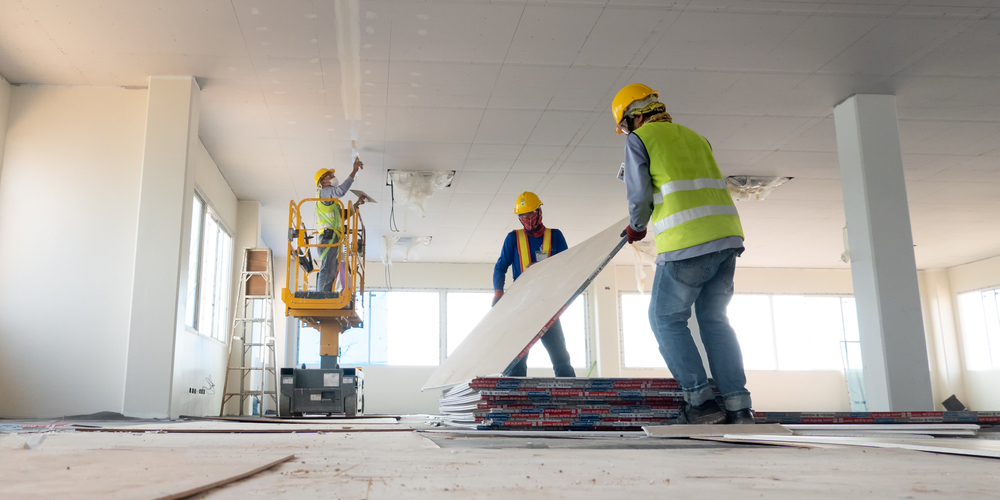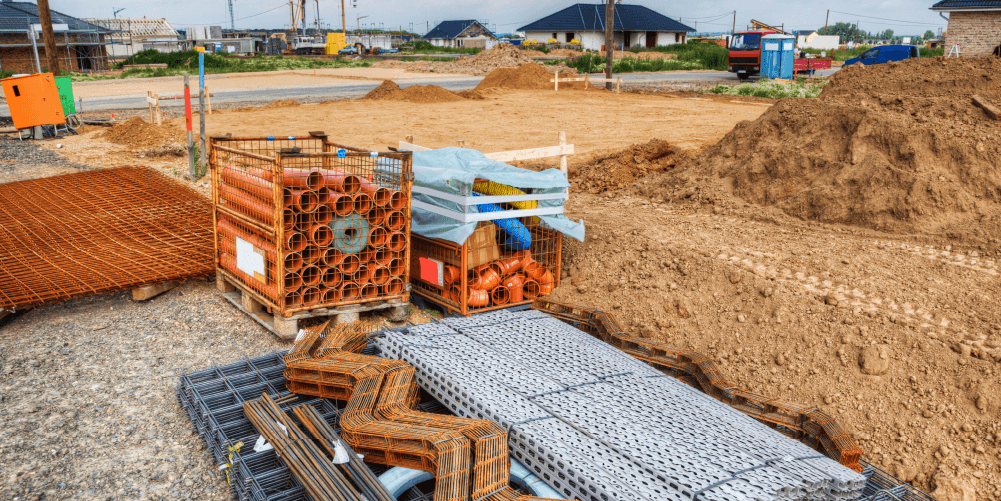— 8 min read
The Carrying Cost of Slow Payment in Construction
Last Updated Jun 6, 2024
Last Updated Jun 6, 2024

When payments on a construction project are delayed, it’s not just inconvenient — late payments can get expensive. Each day that a contractor has to wait to collect, they lose money via inflation, debt interest, and opportunity cost. These are the carrying costs of slow payment in construction — the amount it costs to carry someone else’s debt.
When a business neglects to account for the carrying costs – and pass them on to their customers – they lose money. Contractors must, at the very least, calculate carrying costs in order to create an accurate estimate of the total cost for each project.
Table of contents
Construction payments take time
The construction industry suffers from long payment cycles, especially on large commercial and public projects. Studies by DNB and PWC found that the average days sales outstanding (DSO) for construction companies is anywhere from 51 days to 83 days, respectively. This means that, on average, contractors wait approximately two to three months to collect payment after invoicing.
The practice of withholding retainage on construction contracts can make financial matters worse for contractors. On long-term construction projects where retainage is withheld, contractors may not be entitled to collect the full contract amount for years. Though it depends on the contract and statutory requirements, retained funds are often held until after the project is complete.
Regardless of the duration, any payment delay comes with a variety of costs.
The cost of time
There’s a concept in economics called the Time Value of Money. The concept is pretty simple. If you’re familiar with the expression “time is money,” you already know what we’re talking about.
Imagine that you put a dollar bill in your pocket today, and find it in the laundry 10 years from now. Will it be worth the same in a decade as it is today? It’s still worth a dollar. But in ten years, everything will be more expensive than it is today. So that dollar will be worth less — it will have lost value over time.
The reason is something you hear about a lot in the news: Inflation. The inflation rate is basically the rate at which things get more expensive overall. Inflation is why you could buy a house for $15,000 in 1970, but you’d be lucky to find one for less than $150,000 today.
So what does this mean for your construction business? Every day you work without getting paid, the money you’re earning becomes less valuable. If the property owner waits 90 days to pay you, you’re basically giving them a loan for that amount. But instead of earning interest on that loan, you’re paying the inflation rate.
Here’s an example. You do $10,000 worth of work on a house for Smith Contractors, and send an invoice. Smith takes 90 days to pay. How much inflation did you pay on that $10k?
- 2.9% / 365 days = 0.007% inflation per day
- 0.007% x $10,000 = $0.79 per day
- 90 days x $0.79 per day = $71.52
Seventy bucks might not sound like a lot. But imagine if that invoice is $50, $100, or $250,000. The more money you have on the table, the more expensive time gets.
So, time costs money in the form of inflation. But that’s just one of the costs.
The cost of interest
The inflation rate isn’t the only cost of slow or late payments. They are also subject to interest — whether you use your own money or borrow to cover the gap.
While you’re waiting to get paid, you still have bills to pay. Your employees need a paycheck. Trucks need gas. Suppliers are sending invoices. You can’t put your business on hold while you wait for the check to come in.
You have to get money from somewhere to pay your expenses in the meantime. Where does that money come from? It’s either coming from a loan or your savings. In either case, you’re paying interest.
Interest on loans
A loan is money that you’re borrowing from someone else, like a bank or credit card company. And they’re not giving you that money out of the goodness of their heart. They’re charging you interest on that loan.
If your business is financially sound, with good construction accounting practices and audited financial reports, you might be able to qualify for a bank loan — perhaps the cheapest form of construction financing available. The prime rate (the lowest interest rate generally available to commercial customers) varies based on the Federal Reserve rate, and has ranged from 3.25% to 9% in the past 20 years.
But if you’re using credit cards to pay your bills, and carrying a balance, you’re paying a lot more than the prime rate.
Interest on savings
If you’re fortunate enough to have business savings to meet your expenses while you wait for payment, there’s still a cost. Remember, you’re basically borrowing your own money to pay your employees and suppliers, while your customer holds onto the cash that you’ve already earned.
If you were able to put that money into a savings account, you may be able to earn a modest return. But you’re not earning anything on it, since you’re using it to pay your bills. As a result, it becomes a cost to you.
That’s what economists call an “opportunity cost.” If you didn’t spend that money, you could be using it on something else — an opportunity that earns income.
Courses about construction.
For construction.
Unlock your career potential with our free educational courses on Health & Safety, Data in Construction, and more.
The cost of lost profit
One of the costs of consistently waiting for slow construction payments is slower growth resulting from lost profit. Every business needs profit in order to grow — that money is reinvested in income-producing assets, new projects, etc. that drive more revenue.
Consider this scenario: Three identical contractors work on the same type of construction project. Every project they work on is worth $10,000, with a 10% margin. However, they work for different customers who pay at different times.
- Jones Construction gets paid in 30 days
- Smith Construction gets paid in 60 days
- Harris Construction gets paid in 90 days
They each earn $1,000 in profit on each job. How much profit has each contractor collected at the end of a year?
At the end of January, the first project ends, and they all submit invoices to their customers. At the end of the second month, Jones Construction gets paid for the first job. By the end of the third month, Jones Construction gets paid for their second job, while Smith Construction gets paid for their first, and Harris Construction is still waiting, and so on.
Assuming they put all of their profit in the bank, here’s what each company’s account looks like at the end of December:
- Jones Contractor: $11,000
- Smith Contractor: $5,000
- Harris Construction: $3,000
This is a simplified example, but the result should be clear. Faster payment means a faster turnaround time — you can use the money you earn on one job to reinvest in another. What you don’t see in the example above is the work that Smith and Harris were forced to turn down because their credit cards and supplier accounts were maxed out and they didn’t have any money to take on new projects.
Slow payments keep your construction business from growing.
If you’re preparing accurate construction accounting reports, you should be able to quickly identify your average monthly profit rate from last year. Or take your average profit from your job profitability reports over the last 12 months.
How to calculate carrying cost
Here’s a simple formula to calculate the monthly cost of slow payments:
Inflation % + interest % + profit % = Carrying cost %
This is what that looks like in practice:
- Monthly inflation (2022): 8.5% / 12 = 0.71%
- Monthly interest rate (credit card): 17% / 12 = 1.42%
- Potential profit rate (lost business): 5%
- Monthly carrying cost = 7.13%
How much is faster payment worth?
Knowing how much slow payments cost you isn’t supposed to be a depressing exercise. It’s meant to help you understand your business better, so you can be charging your customers accurately and taking steps to reduce costs. Knowing the cost of slow payment actually helps you get paid faster.
Early payment discounts
If you know that you’re paying 10% each month in carrying costs, you could offer a 5% discount to your customers for immediate payment. Or, you might consider factoring your construction invoices at a 3% per month discount rate, and getting a percentage of that invoice in cash within days after you submit it.
Late payment penalties
If you have problematic customers who refuse to pay you on time, you should be passing the carrying cost on to them. If you don’t feel comfortable charging a late payment penalty, that’s understandable. Just make sure you increase your bid on the next project to incorporate the extra carrying cost that you know you’re paying.
Speed up payment to reduce carrying cost
By now it should be clear that when your customers pay late, you’re paying the price. Slow payments cost you money. And in construction, payments are slow. So what can you do?
Understanding the carrying cost of slow payment helps you to make financial decisions that save you money and speed up payments. But hopefully, understanding how much late payments cost will motivate you to adopt some good business habits that will speed up collections — and help save money — naturally.
Was this article helpful?
Thank you for your submission.
100%
0%
You voted that this article was . Was this a mistake? If so, change your vote here.
Scroll less, learn more about construction.
Subscribe to The Blueprint, Procore’s construction newsletter, to get content from industry experts delivered straight to your inbox.
By clicking this button, you agree to our Privacy Notice and Terms of Service.
Categories:
Tags:
Written by
Jonny Finity
29 articles
Jonny Finity creates and manages educational content at Procore. In past roles, he worked for residential developers in Virginia and a commercial general contractor in Bar Harbor, Maine. Jonny holds a BBA in Financial Economics from James Madison University. After college, he spent two and a half years as a Peace Corps Volunteer in Kenya. He lives in New Orleans.
View profileExplore more helpful resources

Job Profitability Reports: Turning Data into Strategic Decisions
In the construction industry, understanding the financial position of each job can be key to a company’s success. Job profitability reports provide a clear view of a project’s financial performance,...

Earned Value Analysis in Construction: Understanding the Intersection of Cost, Schedule and Scope
Earned value management (EVM) is a powerful tool that intertwines cost, schedule, and scope to offer a holistic view of a project’s progress and performance. This analysis enables construction firms...

Lines of Credit in Construction: The Pros & Cons for Contractors
In the construction industry, contractors often spend large sums of money on materials and other project expenses before they actually get paid for their work. This situation creates a significant...

Trade Credit: The Benefits & Risks to Contractors and Suppliers
Contractors often need to find alternative ways to purchase materials for a project upfront, and one of the most common types of supplier financing options is trade credit. Trade credit...